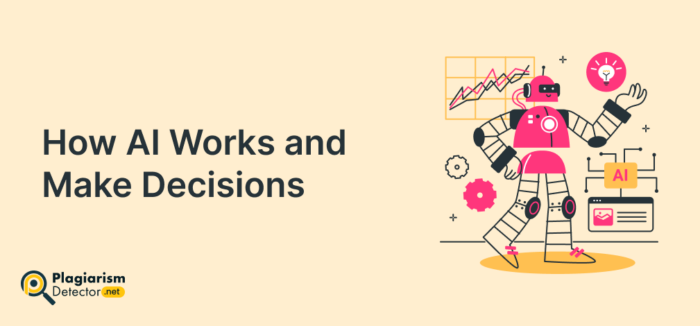How AI Works and Makes Decisions

Artificial Intelligence (AI) is no longer an innovative or novel concept used only in fiction movies. It has become a part of our everyday lives. It provides convenience through personalized recommendations and voice assistance for performing various tasks.
But beyond these services, AI is transforming multiple industries. This technology is primarily utilized in healthcare, finance, and transportation to make complex decisions that would take humans hours to figure out.
In this article, we will discuss AI’s fundamental processes to accurately provide solutions for problems and explore the elements that can impact these decisions.
Artificial Intelligence
Artificial intelligence (AI) is a set of technologies that enable computers to perform various advanced functions. Simply, AI enables computers to think and learn in ways that mimic human problem-solving.
Most tasks require human intelligence, such as recognizing patterns, making decisions, translating different languages, and judging like humans. However, computer programs are now trained to utilize their intelligence and skill to overcome these issues. That’s why they are becoming a significant part of multiple corporations.
One such type of AI is augmented intelligence, which helps humans to provide accurate solutions. This is a by-product of enhanced intelligence, designed to assist humans in their tasks rather than replacing them.
Now, let’s have a look at how this innovative technology works to generate solutions.
How AI Works
AI works by learning from a vast amount of data. These systems learn by analyzing large amounts of information and recognizing patterns. This process helps AI improve over time and make better decisions.
There are two main ways AI learns: supervised learning and unsupervised learning. In supervised learning, AI is given labeled data, which means that it knows the correct answer in advance. Meanwhile, in unsupervised learning, AI is trained on data without labels, and it has to figure out patterns on its own.
An AI-powered machine gets better as it learns to spot these patterns. This allows it to make predictions or decisions based on what it has learned. The best example of artificial intelligence is AI Detector, as it processes billions of websites in a few seconds and shows AI-generated content to you with accurate results.
AI tools utilize neural networks and deep learning techniques to learn data and patterns. These technologies assist systems in processing complex tasks as humans do.
Now, a question arises: how does AI carry on making decisions?
AI Decision-Making Process
AI decision-making can seem complicated. However, it follows logical steps, just like humans do when solving problems. Here’s a simple breakdown of how AI concludes.
Data Collection:
AI starts this process by gathering information from various sources, such as images, text, or numbers, depending on the type of problem.
Preprocessing:
Once the data is collected, it is processed and organized. This involves eliminating irrelevant or messy information and ensuring that only useful data is used for decision-making.
Feature Extraction:
AI identifies the most critical parts of the data, called features. For example, if AI is analyzing images, it will identify features, including colors, shapes, texture, or edges.
Training:
The AI is trained to find patterns in the data and make predictions based on those patterns with the help of algorithms. Multiple techniques are used to find the answers to the queries.
Prediction:
After learning from the data, the AI uses its training to provide solutions. This might be recognizing an object within a photo, predicting future trends, providing a solution, or giving recommendations.
Feedback Loop:
If the AI makes a mistake or gets something wrong, feedback helps it learn from those errors. This is a vital part of improving accuracy over time.
Factors Influencing AI Responses
AI’s responses are only sometimes perfect, and several factors can influence the outcome. These factors can make or break an AI system’s effectiveness at making decisions.
Quality of Data
The outcome indeed depends on the quality of the input data. Decisions are negatively impacted if AI learns from incomplete, outdated, or biased data. Detailed and complete data leads to better results.
Influence of Data
The results provided by AI systems are highly influenced by their training. If AI is programmed on data that contains wrong information, it may produce inaccurate decisions. That’s why it is essential to monitor and balance the data used to train AI carefully.
Uncertainty of Answer
AI doesn’t always give a simple yes or no answer. Instead, it often provides solutions based on probability. For example, it might say there’s a 90% chance an image contains a cat. When the probability is low, AI might struggle with accuracy.
Complexity of the Task
Some decisions are more complex for AI than others. AI can easily recognize patterns in straightforward tasks like identifying objects. On the other hand, it may struggle with more abstract or subjective problems, such as interpreting human emotions.
Wrap Up
With the advancement of technology, AI-powered computers are becoming robust and more reliable. They can now perform tasks that were performed by human brains only. Humans use reasoning to analyze problems and make decisions based on logic.
Now, with deep learning methods and advanced algorithms, AI can do it, too. However, the ethical approach must be kept in mind before incorporating it into the work process. And remember, human intelligence is always required to get the best out of AI.



